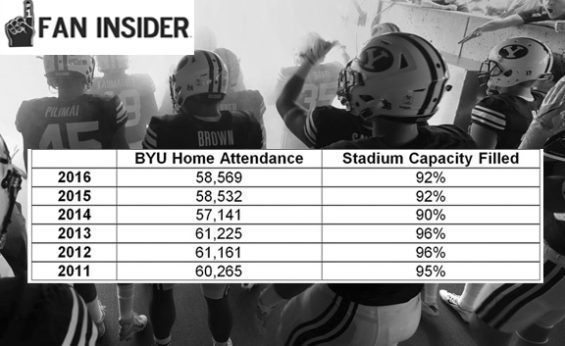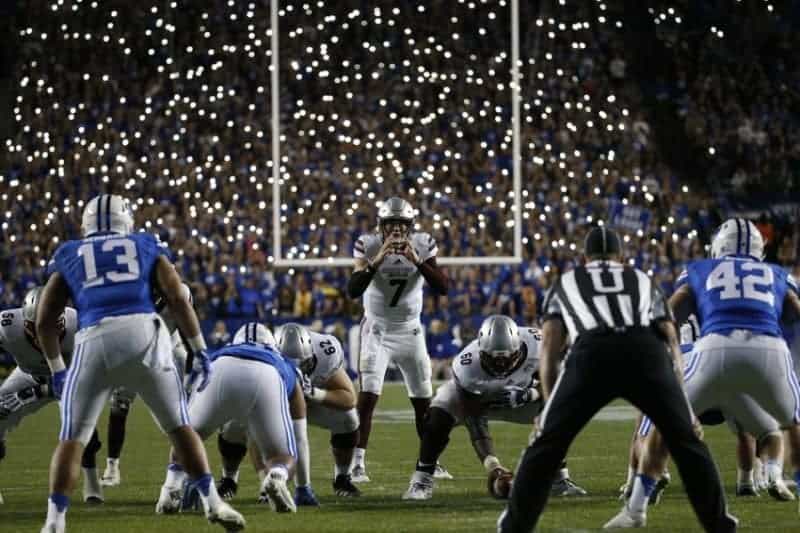In less than 10 weeks, BYU will open the college football season on national television against Portland State.
With it being the season and home opener in “Happy Valley” one would expect the Cougars to play in front of a sold-out crowd at LaVell Edwards Stadium.
But will that really be the case? And is that realistic?
While college football continues to increase in popularity — passing both the NBA and MLB to become the second most popular spectator sport in the United States — FBS home attendance has been challenging as most schools across the country have seen a significant drop over the past six consecutive seasons.
Instead of buying tickets and making it an all-day event, fans have continued to go another route as TV and streaming providers continue to see large increases in viewers.
Just this past year alone, FOX Sports recorded its most-watched college football season ever with an 11 percent increase in viewership. On ESPN’s networks (ABC, ESPN, ESPN2, etc.), nearly 180 million fans watched more than 100 billion minutes of college football in 2016-17.
And according to NCAA data, FBS crowds averaged 43,612 fans per game in 2016, which was down one percent for the second consecutive year. But compared to a four percent decline in 2014, the past two years seem like small victories for athletic departments across the country.
There are a lot of factors at play such as the rise of the internet and streaming companies as well as games times, opponents, ticket prices as well as team performance.
So how does BYU stack up?
BYU Football Attendance
After joining the Mountain West Conference in 1999, the Cougars left for greener pastures as the football program went independent in 2011, while other sports went to the West Coast Conference.
This year, BYU enters its seventh year as a football independent. And since making the switch, attendance at BYU football games has been mixed.

The first three years of independence brought over 60,000-plus fans which filled up 95-96 percent of the stadium capacity. However, in the following year, attendance dropped six percent to just over 57,000. In 2015 and in 2016 attendance picked up a bit as the home crowd filled up 92 percent of the stadium capacity.
After winning 10 games in its first year as an independent, attendance nudged up a bit in 2012 and 2013 despite the football program going 8-5 during those years. In 2014, when attendance dropped six percent, the team still went 8-5. The home schedule didn’t drop off dramatically either as the Cougars hosted Houston, Virginia as well as in-state foe Utah State.
Attendance was nearly identical for the Cougars in 2015 as it was in 2016, despite a new head coach in Kalani Sitake. Surprisingly, in his home opener at LaVell Edwards Stadium, the Cougars didn’t even get a sellout despite going up against one of the top Pac-12 teams in UCLA.
Looking on a national scale, BYU was one of 64 teams — out of 128 — who experienced a positive year-over-year percentage gain in attendance in 2016. The Cougars ranked 28th overall and had the largest crowds outside P5 conferences.
Looking just at P5 conferences, the SEC saw a one percent drop while the Big Ten saw a one percent gain. In the Big 12, attendance was up one percent to end three consecutive years of declining attendance.
In the “Conference of Champions,” Pac-12 crowds declined three percent in 2016 and were down more than 14 percent since 2007. The ACC enjoyed the biggest gains of any P5 conference — up three percent — thanks to big boosts by Louisville, Florida State, Duke, and Miami.
#BYU football home attendance over the years. #BYUFootball #GoCougs pic.twitter.com/y1cY1s4f0c
— Fan Insider (@FanInsider_) June 20, 2017
Conclusion
BYU seems to be treading water at the moment. On the one hand, college football attendance continues to drop, but when compared to the rest of the country, the Cougars are actually in good shape.
At the same time, a new coaching staff usually provides a good boost to attendance during the first year. Michigan, Miami, and Florida all saw huge attendance jumps during the first year of a new coaching staff. But in Sitake’s first year, home attendance basically stayed the same.
During the Mountain West days, 95.9 percent of fans filled LaVell Edwards Stadium compared to just 93.5 percent so far in independence. Of course, some of that also factors into BYU’s deal with ESPN.
During the Mountain West days, it was hard for fans to watch the Cougars on television which is likely one of the key reasons why attendance was so high.
Over the past four seasons, 32 of BYU’s broadcasts have been on major national television channels (ESPN, ESPN2, ABC, NBC, CBS, FOX). Only 15 teams in the nation have had more exposure than the Cougars have had. And with so much exposure, it’s easier for Cougar fans to stay home and watch their team on national television.
But with arguably one of its best home slates in program history this year — with games against Wisconsin, Utah, Boise State, and Utah State — Cougars fans will show their true colors as Sitake looks to guide the Cougars to an even better record in his second season.
Follow Fan Insider on Facebook and on Twitter.
BYU’s Kalani Sitake Continues Program Transformation As Cougars Add A Pair Of Prized Recruits












